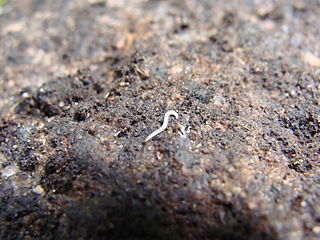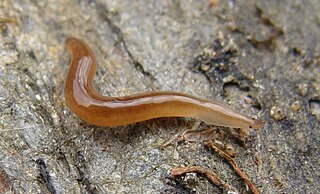
Planarians (triclads) are free-living flatworms of the class Turbellaria, order Tricladida, which includes hundreds of species, found in freshwater, marine, and terrestrial habitats. Planarians are characterized by a three-branched intestine, including a single anterior and two posterior branches. Their body is populated by adult stem cells called neoblasts, which planarians use for regenerating missing body parts. Many species are able to regenerate any missing organ, which has made planarians a popular model in research of regeneration and stem cell biology. The genome sequences of several species are available, as are tools for molecular biology analysis.

Dugesia is a genus of dugesiid triclads that contains some common representatives of the class Turbellaria. These common flatworms are found in freshwater habitats of Africa, Eurasia, and Australia. Dugesia is best known to non-specialists because of its regeneration capacities.

Planariidae is a family of freshwater planarians.

Geoplanidae is a family of flatworms known commonly as land planarians or land flatworms.

Continenticola is a clade that includes the land planarians (Geoplanidae) and the freshwater triclads.

Dugesiidae is a family of freshwater planarians distributed worldwide. The type genus is Dugesia Girard, 1850.

Girardia is a genus of freshwater planarians belonging to the family Dugesiidae.

Dendrocoelidae is a family of freshwater tricladida flatworms that has a holarctic distribution.

Maricola is a suborder of triclad flatworms including species that mainly inhabit salt water environments. However, some species are also known from freshwater or brackish waters.

Planarioidea is a superfamily of freshwater triclads that comprises the families Dendrocoelidae, Kenkiidae and Planariidae.

Geoplanoidea is a superfamily of freshwater and land triclads that comprises the species of the Geoplanidae and the Dugesiidae families.
Cura is a genus of freshwater flatworm (triclads) belonging to the family Dugesiidae.

Dimarcusidae is a family of triclads found mostly in freshwater habitats of caves, although at least one species, Rhodax evelinae, occurs in surface waters. Currently the family contains only seven species distributed in five genera, although the total number of species is thought to be much higher.

Microplaninae is a subfamily of land planarians.
Neppia is a genus of dugesiid triclad that is found in South America, Subantarctic region, Africa, Tasmania and New Zealand.

Bdellocephala is a genus of freshwater triclad that inhabits different regions of Eurasia.

Geoplaninae is a subfamily of land planarians endemic to the Neotropical region. Members of this family are sometimes referred to as the Neotropical land planarians. However, one species, Obama nungara has been introduced in Europe.

The reproductive system of planarians is broadly similar among different families, although the associated structures can vary in complexity.

Rhynchodeminae is a subfamily of land planarians with a worldwide distribution.

Caenoplanini is a tribe of land planarians in the subfamily Rhynchodeminae mostly found throughout the Australasian and Oceanian realms.















